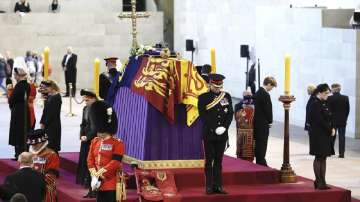Queen Elizabeth II will be laid to rest on Monday, as a sea of mourners, including the Royals, other family members, world leaders and locals, braved the chill to pay their last respects to the United Kingdom's longest-reigning monarch.
According to British media reports, the Queen's coffin is made of English oak, lined with lead and it was built decades ago.
Media reports stated the coffin is made of oak from the Royal Family's Sandringham Estate according to royal tradition.
People make their way along the Long Walk towards Cambridge gate to lay flowers for the Queen in Windsor, England
Reports further said the coffin was originally built by the specialist firm Henry Smith over three decades ago. The records of the exact date that the casket was made were lost when Henry Smith was taken over by another firm in 2005.
Since its manufacture, it has been in storage under the care of two different firms that have been responsible for royal funerals.
The coffin is two-in-one, with the internal portion lead poured over a simple inner wood coffin.
The combination of materials used to make Her Majesty’s coffin means that it is much heavier than a normal coffin. It requires eight pallbearers, which will be from the Armed Forces, to carry it instead of the normal six.
The practice of encasing Royal Family members in lead coffins dates back hundreds of years at least to Queen Elizabeth I.
Using lead allows the casket to be sealed, keeping out moisture and slowing the decomposition process for up to a year longer than would normally occur.
Since lead doesn’t decay, the airtightness of the casket is not compromised which also keeps any smells and gases from escaping.
Both qualities are important when interring a body above ground as will be the case with Queen Elizabeth II at her final resting place in the royal vault called King George VI Memorial Chapel.
Britain's Queen Elizabeth II photographed at Windsor Castle, Windsor, England, in May 2022
Former Prime Minister Winston Churchill, Prince Philip and Princess Diana all had such coffins made for them, Sarah Hayes, manager for the Coffin Works museum in Birmingham, has said.
"It's to preserve the body for as long as possible, it's really about slowing down the process of decomposition," she said.
(With inputs from PTI)
Also Read | Queen Elizabeth II funeral: Man runs up to touch coffin in Westminster Hall, gets arrested | Watch
Latest World News

